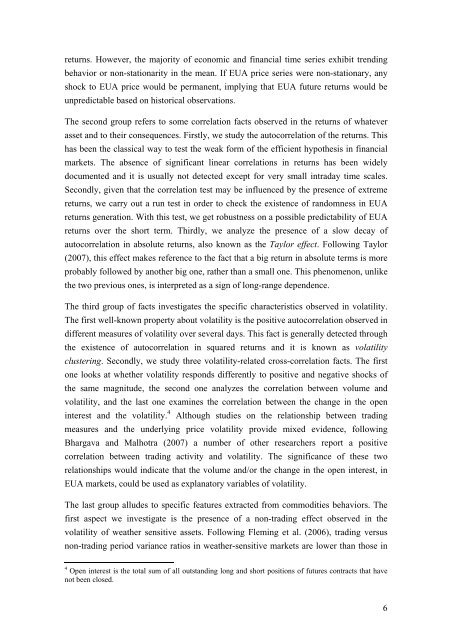You also want an ePaper? Increase the reach of your titles
YUMPU automatically turns print PDFs into web optimized ePapers that Google loves.
eturns. However, the majority of economic and financial time series exhibit trending<br />
behavior or non-stationarity in the mean. If EUA price series were non-stationary, any<br />
shock to EUA price would be permanent, implying that EUA future returns would be<br />
unpredictable based on historical observations.<br />
The second group refers to some correlation facts observed in the returns of whatever<br />
asset and to their consequences. Firstly, we study the autocorrelation of the returns. This<br />
has been the classical way to test the weak form of the efficient hypothesis in financial<br />
markets. The absence of significant linear correlations in returns has been widely<br />
documented and it is usually not detected except for very small intraday time scales.<br />
Secondly, given that the correlation test may be influenced by the presence of extreme<br />
returns, we carry out a run test in order to check the existence of randomness in EUA<br />
returns generation. With this test, we get robustness on a possible predictability of EUA<br />
returns over the short term. Thirdly, we analyze the presence of a slow decay of<br />
autocorrelation in absolute returns, also known as the Taylor effect. Following Taylor<br />
(2007), this effect makes reference to the fact that a big return in absolute terms is more<br />
probably followed by another big one, rather than a small one. This phenomenon, unlike<br />
the two previous ones, is interpreted as a sign of long-range dependence.<br />
The third group of facts investigates the specific characteristics observed in volatility.<br />
The first well-known property about volatility is the positive autocorrelation observed in<br />
different measures of volatility over several days. This fact is generally detected through<br />
the existence of autocorrelation in squared returns and it is known as volatility<br />
clustering. Secondly, we study three volatility-related cross-correlation facts. The first<br />
one looks at whether volatility responds differently to positive and negative shocks of<br />
the same magnitude, the second one analyzes the correlation between volume and<br />
volatility, and the last one examines the correlation between the change in the open<br />
interest and the volatility. 4 Although studies on the relationship between trading<br />
measures and the underlying price volatility provide mixed evidence, following<br />
Bhargava and Malhotra (2007) a number of other researchers report a positive<br />
correlation between trading activity and volatility. The significance of these two<br />
relationships would indicate that the volume and/or the change in the open interest, in<br />
EUA markets, could be used as explanatory variables of volatility.<br />
The last group alludes to specific features extracted from commodities behaviors. The<br />
first aspect we investigate is the presence of a non-trading effect observed in the<br />
volatility of weather sensitive assets. Following Fleming et al. (2006), trading versus<br />
non-trading period variance ratios in weather-sensitive markets are lower than those in<br />
4 Open interest is the total sum of all outstanding long and short positions of futures contracts that have<br />
not been closed.<br />
6

















